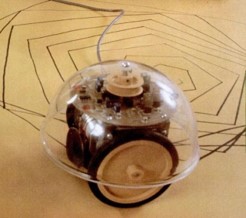Turtle as Mathematician
A virtual hands-on workshop led by Cynthia Solomon, Michael Tempel, Brian Silverman, and Artemis Papert
Once upon a time Turtle Geometry was virtually unknown in K12
education. Now FORWARD and RIGHT, the basic commands in Turtle
Geometry, are incorporated into countless coding apps, games, and
robotics programs. But many educators are not familiar with
the educational and mathematical roots of Turtle Geometry.
We will briefly look at the origins of Turtle Geometry and how it
was seen as an excellent entry path into MathLand for young
learners. The leaders of this workshop have been immersed in
Turtle Geometry for a very long time. They will share their ideas
and experiences along with a collection of engaging activities to
explore yourself and with your students.
Using TurtleArt and Scratch, we will delve into:
- Polygons, Spirals, and other Geometric Patterns – complex and beautiful patterns emerge from the commands of Turtle Geometry
- Probability – Starting with a coin toss, we see how order emerges from randomness, and how this phenomenon applies to many aspects of the real world. We’ll also look at some surprises that result from random events that are repeated many times.


When: |
Saturday, March 20, 2021, 10:00 am to noon EDT |
Where: |
Everywhere via Zoom |
Cost: |
$15 per person Free for people who participated in the 2020 Virtual Logo Summer Institute |
|
|
About the workshop leaders:
- Cynthia Solomon is an American computer scientist known for her work in artificial intelligence and popularizing computer science for students. She is a pioneer in the fields of artificial intelligence, computer science, and educational computing. While at Bolt, Beranek and Newman, she worked with Wally Feurzeig and Seymour Papert to create the first programming language for children, Logo.
- Michael Tempel was a classroom teacher, teacher trainer, and curriculum developer in the New York City Public Schools for 14 years, worked on Logo software development and educational programs at Logo Computer Systems Inc (LCSI), and was part of the Epistemology and Learning Group at the MIT Media Lab. In 1991 he and Seymour Papert co-founded the Logo Foundation. He first began working with students, teachers, and turtles in 1980 as part of the Computers and Schools Project and has been doing so ever since.
- Artemis Papert is an artist creating art in both traditional, mainly acrylic and pastel, and digital media, using code as the medium. After a first career as a research biologist she retrained in the healing art of shiatsu. With an interest in dream and fairy tale interpretation and as a lifelong learner, she is currently training to become a Jungian psychoanalyst. Artemis has led TurtleArt workshops for a wide variety of groups in many countries.
- Since the late 1970s, Brian Silverman has been involved in the invention of learning environments for children. His work includes dozens of LOGO versions, LogoWriter and MicroWorlds among them, Scratch, LEGO® robotics, TurtleArt, the PicoCricket, and the Phantom Fish Tank. Brian has been a Visiting Scientist at the MIT Media Lab, enjoys recreational math, and is a computer scientist and master tinkerer. He once even built a tic-tac-toe playing computer out of TinkerToys.
Resources for This Workshop
Programming Environments
We will be using the web version of TurtleArt:
https://www.playfulinvention.com/webturtleart/ Please verify that you can run this on your laptop. If you have trouble, emails us at info@logofoundatio.org before the workshop and we'll help resolve any issues.
We'll also be using Scratch: https://scratch.mit.edu/
If you don't already have an account on the Scratch website, please Join Scratch before the workshop.
Projects
Exploring Turtle Geometry through Polygons and
Spiralsby Cynthia Solomon
Cynthia will be referring to this paper in the workshop. Click here to download a copy.
Randomness
Flip a coin. What does a graph of the proportion of heads and tails look like over time?Look at the Scratch project Coin Toss and watch the graph emerge. There's lots of jumping around at the beginning, but it settles down predictably as time goes on.
Coin Toss Too is the same as Coin Toss but you can vary the total number of tosses with a slider.
Coin Toss Visualization shows various visualizations (and a sonification) of tossing a coin many times.
When you toss a coin repeatedly, you sometimes get two or more heads in a row. After lots of tosses, what do you expect? What actually happens? Flip is a Scratch project that you can use to flip a virtual coin zillions of times. Also look at the TurtleArt project Color Flip for a visualization of this phenomenon. (click here to download a Zip file that includes this project.)
Have the turtle move forward or back, randomly choosing which way to go. The TurtleArt project Drift illustrates this. Drift2 is the same but adds a feedback mechanism to limit the drift. (click here to download a Zip file that includes these two projects.)
More About Turtle Geometry
- The TurtleArt website is the source for TurtleArt software, tutorials, and an extensive gallery of images.
- A Logo Primer is a brief introduction to Turtle Geometry and the Logo programming language.
- An Introduction to Logo and Turtle Geometry is a a series of brief video clips in which Seymour Papert introduces Logo and Turtle Geometry. The clips are excerpts from Seymour Papert: On Logo.
- Logothings is a website about Logo that is maintained by Cynthia Solomon. It includes a section with turtle geometry projects.
- Logo Overnight by Mitch Resnick includes activities on the theme of this workshop.
- Mindstorms by Seymour Papert. Chapter 3 is about turtle geometry.
- Turtle Geometry by Harold Abelson and Andrea diSessa contains a wide range of advanced explorations.
- Visual Modeling with Logo by James Clayson is an exploration in visual thinking with Turtle Geometry
- Inventive Minds: Marvin Minsky on Education by Marvin Minsky Edited by Cynthia Solomon, Xiao Xiao
- History of Logo by Cynthia Solomon, et. al.